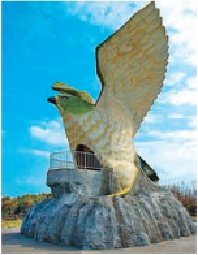Travel Reference
In-Depth Information
Funausagibanata Observatory, one of the three observatories at Cape Shiratori is in the shape of a giant
grey hawk native to Irabujima.
Also attractive and worth seeing is the wild and dramatic scenery of the north end of the
island. It's a reserve called Nishikaigan Park (
西海岸公園
; Nishi-kaigan kōen; lit. “West Coast
Park”). The northernmost tip is crowned with three observatories at Cape Shiratori (
白鳥岬
;
Shira tori zaki; lit. “White Bird Cape”). Two are the regular type of round concrete struc-
ture, the third is in the shape of a giant grey hawk native to the island. It's the
sashiba
(
サシ
バ
; Latin:
Butastur indicus
; also known as the “grey-faced buzzard”). The three observator-
ies are within 1 mile (two kilometers) of one another and a hiking trail connects them. The
“hawk” lookout is called Funausagibanata Observatory (
フナウサギバナタ展 望台
; Funaus-
agi banata tenbō-dai)
From Irabu it's easy enough to get to Shimoji. The two islands run side by side straddling
a narrow channel of seawater for 2 miles (3 kilometers). The channel is never more than
around 100 meters wide and it's crossed every few hundred meters by a total of six bridges
connecting the two islands. We'll go there next.
3
SHIMOJIJIMA
下地島
Unlike Irabu, which is densely settled and has two villages, Shimojijima (
下地島
;
Shimojijima) is almost uninhabited. It's a small island, half devoted to sugar cane and half
devoted to an airport, but most of the sugar cane planters and the airport personnel don't live
there. They commute from Irabu. The island is almost devoid of dwellings. The few that exist,
maybe a dozen, are found on the island's northeast, just across the sea channel from Irabu


